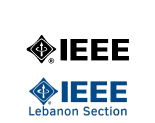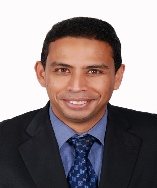









Prof. Dr. Ezzeldin A. Soliman Received the BSc degree (distinction with honors) in
electronics and communications engineering from Cairo University in June 1992. In
June 1993 he received a diploma from Cairo University in engineering physics, which
is equivalent to a Bachelor of Science in physics. He received his MSc degree in
engineering physics from Cairo University in November 1995. In June 1996, he joined
both the Interuniversity Micro Electronics Center (IMEC), Belgium, and the Department
of Electrical Engineering (ESAT) of the Katholieke Universiteit Leuven, Belgium.
He received his PhD degree (summa cum laude) in electrical engineering from the Katholieke
Universiteit Leuven in February 2000. Dr. Soliman held the following positions: Assistant
Professor at Cairo University (2000-2005), Visiting Assistant Professor (on leave
from Cairo University) at McMaster University, Canada (2002-2003), Associate Professor
at King AbdulAziz University, KSA (2005-2007), Associate Professor at the American
University in Cairo, Egypt (2007-2012). Since 2013, he is a Full Professor at the
AUC. Prof. Soliman is a Research Affiliate at the Department of Electrical Engineering,
Telecommunications and Microwaves Division, KU Leuven, Belgium. He was a Visiting
Professor at both IMEC and KU Leuven many times in the period 2002-2013. He has been
a Visiting Professor at McMaster University, Canada, during Spring 2014, Fall 2014,
and Summer 2015.
Prof. Soliman has three main lines of research. The first line is concerned with
the development of novel integrated antenna systems. His research in this area covers
a wide range of operating frequencies, such as: planar antennas operating in the
RF and microwave ranges, in addition to micromachined antennas operating in the millimeter-wave
and sub-millimeter-wave ranges. Prof. Soliman has invented several new antennas for
different applications, such as: wireless local area network (WLAN), radio frequency
identification (RFID), ultra wide band (UWB) communication, wireless personal area
networks (WPAN), biomedical imaging, radar systems, and THz imaging systems. His
second line of research is directed towards computational electromagnetics. He has
been interested in developing new techniques for the efficient and accurate simulation
and optimization of planar antennas in layered media using the integral equations
formulation. His recent research interest is the field of plasmonics and nano antennas
and their applications in solar and thermal energy harvesting, optical communications,
and biomedical sensing. Prof. Soliman holds five patents in the area of integrated
antennas. He has published over 65 peer-reviewed technical papers in reputable international
journals in the field, in addition to more than 55 publications and presentations
in well-recognized international conferences. Prof. Soliman received 4.75 Million
USD as PI or Co-PI in several funded research projects. He is a Senior Member in
the Institute of Electrical and Electronic Engineers (IEEE). He is the Founder and
Director of the Microwave and Millimeter-Wave (MMW) Laboratory at AUC. He is the
recipient of the “Excellence in Research and Creative Endeavors Award” offered by
the AUC on 2011, and the “Outstanding Scholarly Research” offered by School of Sciences
and Engineering at the AUC on 2010.

Abstract:
Tiny Integrated Antennas from the Micro-Scale down to the Nano-Scale
For easier integration of the driving electronic chips and the antenna, the latter
is preferred to be realized on a silicon wafer, i.e. an on-chip antenna solution.
Working at high frequencies results in having small and light weight devices because
as the frequency of operation increases, the size of the antenna decreases. However,
the operation in the mm-wave range, such as 60/77/94 GHz, triggers surface waves
inside the silicon substrate carrying on-chip antennas. Moreover, if low-resistivity
silicon is used which is preferable for active devices, ohmic losses become significant.
In order to get rid of surface waves and ohmic losses, while keeping the antenna
integrated with the rest of components on the
Prof. Dr. Ezzeldin A. Soliman
Professor, Physics Department
School of Sciences and Engineering (SSE)
The American University in Cairo (AUC)
same silicon substrate, micromachining technology is the solution. A new category
of micromachined antennas will be presented. This category offers both relatively
low cost and high isolation between the antenna and its driving electronic circuit.
A number of micromachined antennas belonging to this new category will be presented,
namely: linearly polarized element, linearly polarized antenna with parasitic radiator,
circularly polarized element, reconfigurable element with radiation pattern diversity
(dipole/monopole), dual-band element (60/77 GHz), reconfigurable element with polarization
diversity, and wire-grid antenna arrays. Another micromachined on-chip antenna will
be presented, namely a Dielectric Resonator Antenna (DRA). This antenna is made up
of silicon dielectric etched within the wafer. This illuminates the conductor losses.
However, this solution is not convenient if low-resistivity silicon is used as the
ohmic losses in this case is unavoidable. All these mm-wave challenges will be discussed
and a trade-off between them will be made.
The second part of the presentation will be devoted to nano antennas, i.e. nantennas.
The nantenna can receive or transmit light in the same way as the regular antenna
does in the microwave range. Nano-antennas are recently replacing semiconductor optical
transmitters and detectors owing to their inherent advantages such as: compact size,
fast response, sensitivity to polarization, broadband receiving behavior, directivity,
possible monolithic integration with electronics and optics, and their passive heating
nature that does not require cooling sub-systems. Dipole nantennas terminated by
metal-insulator-metal travelling wave rectifiers for thermal energy harvesting will
be presented. A highly directive wire-grid nano antenna array for point-to-point
optical communication will be introduced. This new nano antenna array can be used
for inter-chip communication where data can be transferred between optical circuits
and/or chips located in close vicinity to each other. A novel mushroom nano antenna
array for sensing blood diabetes is discussed. It has the advantages of being able
to couple directly with the incident light, it has relatively large feature dimension
which reduces fabrication cost, and it offers relatively high sensitivity. Nantennas
are known to be capable of sharp focusing and tight confining of incident light within
spots whose sizes are well-below the diffraction limit and with intensity enhancement
a few orders of magnitude higher than the intensity of the incident light. An array
of novel nano crescent antennas is presented, where the light confinement spectrum
is engineered. The light focusing can be used also in the overheating of cancer tumors
via a new circularly polarized nano ring that offers uniform heating of the malignant
cells. A new E-shaped nano antenna that can deal with single linear or dual-linear
polarizations of light is also developed.




